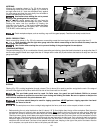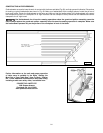
24
CONSTRUCTING A FEATHERBOARD
Featherboards are used to keep the work in contact with the fence and table (Fig. 69), and help prevent kickbacks. Dimensions
for making a typical featherboard are shown in Fig. 69. Make your featherboard from a straight piece of wood that is free of
knots and cracks. Clamp the featherboard to the fence and table so that the leading edge of the featherboard will support
the workpiece until the cut is complete. An 8" high flat board can be clamped to the rip fence and the featherboard can be
clamped to the 8" high board.
Use featherboards for all non-thru-sawing operations where the guard and splitter assembly cannot be
used. Always replace the guard and splitter assembly when the non-thru-sawing operation is complete. Make sure
the featherboard presses only on the portion of the workpiece in front of the blade.
Further information on the safe and proper operation
of table saws is available in the Delta “Getting the
Most Out of Your Table Saw” How-To Book, Catalog
No. 11-400. Additional Information on table saw safety,
including a table saw safety video, is available from:
POWER TOOL INSTITUTE
1300 Sumner Avenue
Cleveland, OH 44115-2851
www.powertoolinstitute.com
Fig. 69
Fig. 70


















